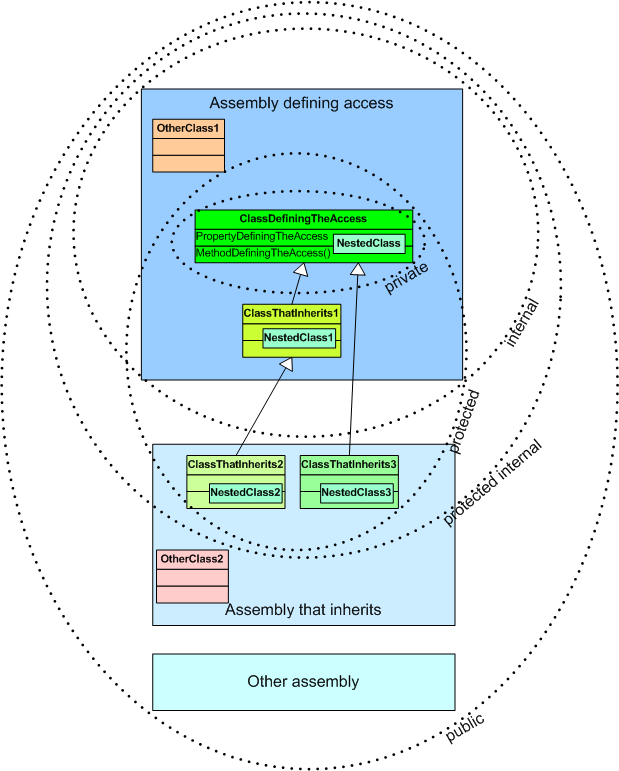
Introduction
This is a very small article to illustrate C# access modifiers. This article is for beginners but even if you are an expert, this article may be useful as a quick reminder when the brain cells slow down - hey, I will probably need it soon.
Definition
An access modifier is a keyword you can add to your declaration of a class or class member to allow or restrict their accessibility.
The diagram above illustrates how each access modifier affects the accessibility of the class or member.
Using the Code
I kind of doubt you will need any more than the diagram as a reminder, but since I want to make this article more complete for beginners, here is some more content.
Now, a few examples:
internal class Class1
{
private int Member1;
protected int Member2;
internal int Member3;
protected internal int Member4;
private class NestedClass
{
void Test(Class1 foo)
{
foo.Member1 = 0;
foo.Member2 = 0;
foo.Member3 = 0;
foo.Member4 = 0;
}
}
}
public class Class2
{
private void Method1()
{
}
private int _Member1;
protected int Member1
{
get
{
return _Member1;
}
set
{
Method1();
_Member1 = value;
}
}
internal int Member2;
public int Member3;
protected internal int Member4;
}
The above access modifiers prevent direct access as seen by the following access attempts. These attempts produce compilation errors:
From the same assembly as the above classes:
class Test
{
void Test1()
{
Class1 c1 = new Class1();
c1.Member1 = 0;
c1.Member2 = 0;
c1.Member3 = 0;
c1.Member4 = 0;
}
}
internal class DerivedClass : Class1
{
private void Test2()
{
Member1 = 0;
Member2 = 0;
Member3 = 0;
Member4 = 0;
}
private class NestedClass
{
void Test(DerivedClass foo)
{
foo.Member1 = 0;
foo.Member2 = 0;
foo.Member3 = 0;
foo.Member4 = 0;
}
void Test(Class1 foo)
{
foo.Member1 = 0;
foo.Member2 = 0;
foo.Member3 = 0;
foo.Member4 = 0;
}
}
}
From a different assembly from the above classes:
public class Test
{
void Test1()
{
Class1 c1 = new Class1();
Class2 c2 = new Class2();
c2.Method1();
c2._Member1 = 0;
c2.Member1 = 0;
c2.Member2 = 0;
c2.Member3 = 0;
c2.Member4 = 0;
}
}
internal class DerivedClass : Class2
{
private void Test2()
{
Member1 = 0;
Member2 = 0;
Member3 = 0;
Member4 = 0;
}
private class NestedClass
{
void Test(DerivedClass foo)
{
foo.Member1 = 0;
foo.Member2 = 0;
foo.Member3 = 0;
foo.Member4 = 0;
}
void Test(Class2 foo)
{
foo.Member1 = 0;
foo.Member2 = 0;
foo.Member3 = 0;
foo.Member4 = 0;
}
}
}
Points of Interest
In the examples above, you restrict direct access to Class2._Member1 but provide a wrapped property called Member1. The requirement is to ensure Method1 is called when _Member1 changes. The access modifiers ensure that we can only change _Member1 via the property.
That concludes the article.
History
- 9th April, 2008: Initial version
- 10th April, 2008: Modified to include more detail
- 14th April, 2008: Modified diagram
This member has not yet provided a Biography. Assume it's interesting and varied, and probably something to do with programming.
 General
General  News
News  Suggestion
Suggestion  Question
Question  Bug
Bug  Answer
Answer  Joke
Joke  Praise
Praise  Rant
Rant  Admin
Admin 








